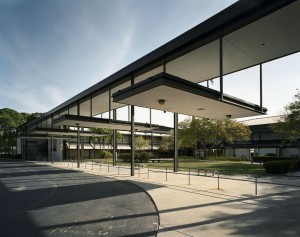Initially when the modernist architecture movement began to gain momentum, many of the Utopian thinkers under the modernist umbrella came under fire for being careless about the historical architecture already in place. Many urban dwellers feared absolute destruction of cities in order to create a new and industrialized plan that coincided with the growing technology of the 20th century. Many of these fears of Modernism requiring complete discontinuity from the past were misconstrued as many modernist architects were actually dedicated to preserving some historical buildings in their new and modern city concepts. The Athens Charter created from the modernist group CIAM demonstrates this dedication as the manifesto describes that, ““whenever this measure [building anew] is attended by the destruction of genuine architectural, historical or spiritual assets, then it is unquestionably better to seek another solution”*. The historical portion of the Athens Charter reflects the necessity of saving historical buildings while trying to build. Therefore, modernism does not typically utilize the building styles of the past but does attempt to salvage as many monuments and buildings as they can. Interestingly today, an issue arises concerning saving the modernist creations of these once considered coming-of-age thinkers. Who is trying to save modernist buildings in today’s world? Many modernist buildings are being torn down to make way for newer buildings that have more contemporary styles associated with them. This process is exemplified by Riverview School in Sarasota, Florida. Riverview School was torn down in 2009. The school was built in 1958 by Paul Rudolph, the leading architect of the Sarasota School of Architecture**.
Interestingly today, an issue arises concerning saving the modernist creations of these once considered coming-of-age thinkers. Who is trying to save modernist buildings in today’s world? Many modernist buildings are being torn down to make way for newer buildings that have more contemporary styles associated with them. This process is exemplified by Riverview School in Sarasota, Florida. Riverview School was torn down in 2009. The school was built in 1958 by Paul Rudolph, the leading architect of the Sarasota School of Architecture**.
 Though the school was an important piece of modernist architecture, it was destroyed to make way for a newer and more contemporary building.
Though the school was an important piece of modernist architecture, it was destroyed to make way for a newer and more contemporary building.
Riverview School is one of many examples of modernist buildings that are being destroyed because there are not deemed worthy of saving. This could be because modernist structures tend to have a “lack of ornamentation makes people say it’s factory-like”*** or were also poorly built in many cases.
Alternatively, there are many groups that do desire to salvage modernist projects for their historical emphasis despite their somewhat ugly appearance. World Monuments Fund contributes to saving some modernist projects in danger of being destroyed and also hosts seminars to raise awareness of modernist architecture’s historical integrity. This fund was responsible for documenting the case of Riverview School and comparing it to a similar German modernist project that was in jeopardy. The seminar that arose from this comparison was called “Modern Solutions for Saving Modern Landmarks”**** and is a fascinating photo-journal about these two modernist buildings. Overall, Riverview School was still destroyed yet the German project, an engineering school, was saved from being torn down due to “its heightened cultural significance”.
Overall, it is shown that saving Modernist landmarks is not a central goal in most communities. The buildings are still relatively recent designs which perhaps devalues their sense of history in the common eye. The modernist viewpoint that emphasized that progress did demand destruction to an extent could ease the pain of tearing down old modernist buildings also. The Athens Charter stated, “Death which spares no living creature also overtakes the works of men”*****. The attitude of building destruction as applied to the lack of caring given to many destroyed modernist buildings could be because of the ideologies behind the necessitated destruction within the modernist movement itself. Therefore, it remains to be seen whether modernist structures gain more prevalent importance in the community as time passes or simply disappear altogether.
Footnotes:
*Athens Charter, pp. 88.
**Stockbridge-Pratt. “Sarasota School of Architecture”, pp.1.
***Bubil, Harold. “Preserving Our Father’s Architecture”, pp.1.
**** Very Interesting Website about the two modernist projects. http://www.dcp.ufl.edu/galleries/modernism-at-risk
*****Athens Charter, pp.86.
World Monuments Fund Website: http://www.wmf.org/dig-deeper/wmf-articles?page=4

This is a really interesting point and certainly brings to the light the question as to whether or not modernist buildings should be deemed worthy for preservation. I’m personally not a huge fan of Modernist architecture as I tend to favor earlier, more ornate, architecture often associated with the bourgeoisie (on a purely aesthetic basis). Having said this, I don’t think aesthetics should be the only consideration in choosing to preserve, or demolish, a building.
Many Modernist architects deemed themselves to be apolitical, however as we have previously discussed in class, this is easier said than done. I think that Modernist architecture does represent important and significant political and sociological shifts (especially in the aftermath of WWII), even though it may not have intended to do so. I certainly agree with your point that the recent construction of many of these landmarks may devalue the historical significance of these buildings, however we must remember that this doesn’t make them any less significant. Ultimately, I think that we should approach the preservation of Modernist architecture in the same fashion that we approach the preservation of any earlier style. This is not to say that we should preserve ALL Modernist examples, just as we should not necessarily preserve all examples of any style, however we should at least give careful consideration that goes beyond the curb-appeal of the building.
How do we choose which examples to preserve?
Very interesting post! To be honest, I had never given much thought to the preservation of Modernist architecture, 1) because it is not that old, and 2) because it is often downright ugly and monotonous! However, it is a distinct period in architectural history that is now over, and therefore can be deemed ‘old’ by historical standards. Furthermore, my personal views on the buildings’ aesthetic appeal are completely subjective and should not have any bearing on whether or not they are preserved.
I think it is easy for us to look back on certain previous architectural styles and see the importance of preserving them because they look really beautiful and their designs are amazing! I don’t think anyone (even Modernists!) would suggest that centuries-old European castles and cathedrals, with their beautiful ornamentation and unique style, should be torn down. However, Modernism is also an extremely unique style of architecture that represents a certain period of history, and from a purely objective standpoint, some representative Modernist buildings must be preserved. Just because they are uber-functional and often rather drab and ugly does not mean they are useless. In fact, just looking at them can explain a lot about the values of the time in which they were built – post-war austerity, the need for mass housing, etc. They are historical timepieces which, in my opinion, deserve preservation along with any and every other style of architecture.